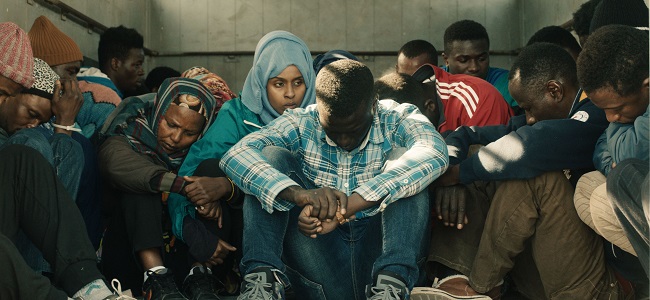The Order of Things (Andrea Segre, 2017): Italy
Reviewed by Savasia J. Vida at the Santa Barbara Film Festival, 2018.
 Director Andrea Segre delivers a powerful film about the complexities of being an Italian immigration officer as Corrado finds himself in a tricky situation to help a Somalian immigrant, Swada, escape from the brutal and prison-like immigration centers in Libya. However, the stylistic features of the film really underline the intensity between Corrado’s actions and Swada’s goals as the specific editing techniques situate the story with a more realism effect to it.
Director Andrea Segre delivers a powerful film about the complexities of being an Italian immigration officer as Corrado finds himself in a tricky situation to help a Somalian immigrant, Swada, escape from the brutal and prison-like immigration centers in Libya. However, the stylistic features of the film really underline the intensity between Corrado’s actions and Swada’s goals as the specific editing techniques situate the story with a more realism effect to it.
The cinematography and mise-en-scene throughout the film play a huge part in dramatizing each characters’ motives as the lack of music highlight the seriousness of the scenes. Within the first few scenes, you can tell that cinematographer Valerio Azzali wants the audience to see every element in the scene in its entirety; by paying close attention to detail, each scene creates this personal tone as if everything in the mise-en-scene has a subtle significance behind it pertaining to Corrado. In addition, the use of wide shots, long takes and minimal cuts within scenes further exploits this personal tone as if we were watching the story unfold with our own eyes rather than through a camera lens.
Beside its stylistic conventions, The Order of Things sheds light on the reality of these harsh immigration centers abroad and how its “inmates” are treated. Corrado frequently visits the Tripoli immigration center in Libya to monitor how things are going between the officers and the immigrants. From the start, we understand Corrado’s uneasiness throughout his visits as he sees overcrowded cells, people crying for help and the overall look of defeat on most of their faces while the officers punishes them frequently to remind them of their brutal authority. When Swada’s approaches Corrado with quickness, she hands him a USB drive of her documents and identity and asks him to send it to her uncle in Italy. Shocked but willing, Corrado takes the drive in secrecy and accomplishes what Swada has asked of him. But as life tends to emphasize the ‘bitter’ in ‘bittersweet’, the relationship between the two intensifies with complications and sacrifices as Corrado’s job and family serve as a reminder of what he should do.
The Order of Things is a must-watch if you appreciate cinematography in films as I felt that Azzali’s work help the structuration of the narrative. Not only is the film’s style important, but the overall message about the complexity within immigration regulations is a theme that signifies its relevance in the contemporary world.
About this entry
You’re currently reading “The Order of Things (Andrea Segre, 2017): Italy,” an entry on Student Film Reviews
- Published:
- 02.20.18 / 7pm
- Category:
- Films, Santa Barbara Film Festival 2018
No comments
Jump to comment form | comments rss [?]